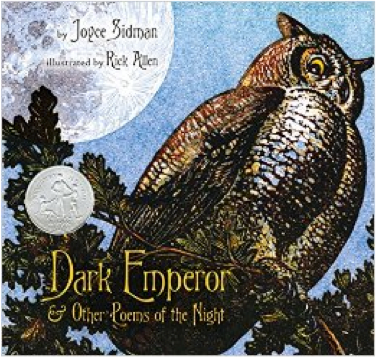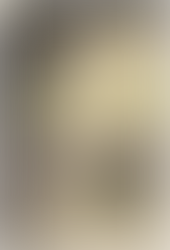Dark Emperor & Other Poems of the Night
- lcollins29
- Apr 27, 2017
- 2 min read

Title: Dark Emperor & Other Poems of the Night
Author: Joyce Sidman
Illustrator: Rick Allen
Publisher: Houghton Mifflin Harcourt
Publication Year: 2010
Professional Source: Kent County Library
Genre (and subcategory, if appropriate): Poetry Book (single author, many poems)
Audience: Children
Awards: John Newberry Medal
Critical Response:
Dark Emperor & Other Poems of the Night is a collection of poetry about nocturnal animals and other aspects of the forest. Readers of all ages will lose themselves within the beauty of the poetry. There are many different styles of poetry sprinkled throughout, such as those with free verse, followed by others that contain rhythm and rhyme. Sidman uses words and concepts simple enough for children to understand, but complex enough for older readers to appreciate. He describes an owl as a “Perched missile, almost invisible” (12) while, in a different poem, Sidman describes the flight of a moth in first person, describing it by saying, “At dawn, I fold my sherbet-colored wings and become a primrose.” (10) All of them are packed with beautiful imagery and metaphors that delights the mind and ignites the imagination.
However, the book also has space for its teaching moments as well. After each poem is a bit of information about the poem’s subject. For example, after reading a poem about owls, readers have the opportunity to read the educational passage filled with facts about owls. This provides readers with the opportunity to better understand the plants and animals in their natural habitat, thus awakening a heightened knowledge, and perhaps even a love, of nature.
Each poem also comes with an illustration that is as detailed as the poems themselves. Allen’s sophisticated art style creates colorful masterpieces that readers will enjoy gazing upon for a long time. Many of the backgrounds contain very soft, pale colors, while the foregrounds are produced with heavy lines and shading. The longer the audience looks, the more details become noticeable until the entire image seems to be leaping off the page. There is so much detail in some of the pictures, that animals (like insects and rodents) become hidden and camouflaged within the foliage. This is the point of some of the images, of course, and they provide a complementary illustration to go with the words. On the other hand, contrasting colors were used for the more dangerous animals and situations. A bright orange spider contrasts heavily against a soft navy blue sky. A pair of black porcupines are covered in sharp, white needles as they sit in the bushes. As Molly Bang points out, “We notice contrasts, or, put another way, contrast enables us to see.” The contrasts allow us to see the potential danger that can come with running into a spider or a porcupine in the dark, and, hopefully, avoid them.






Comments